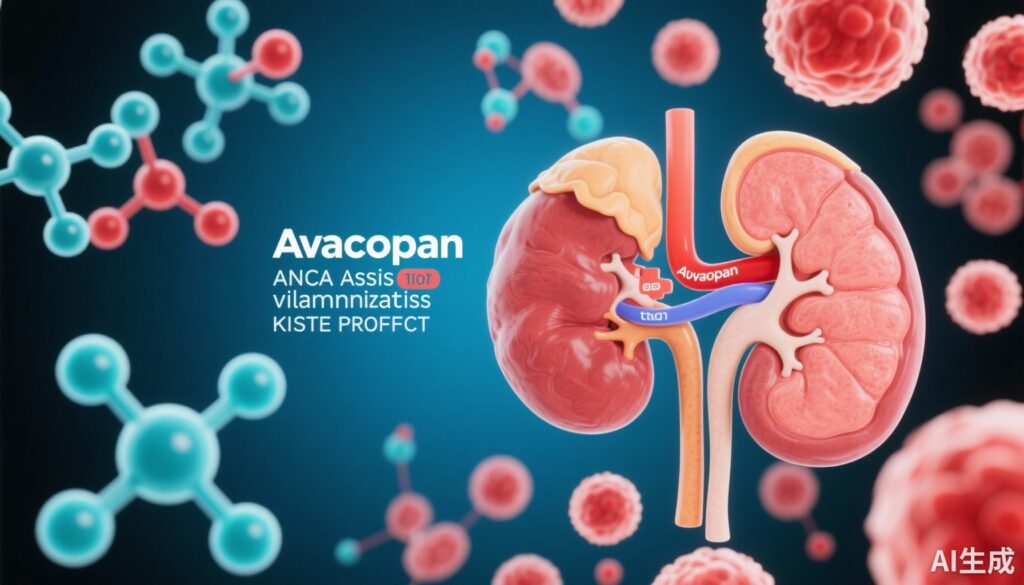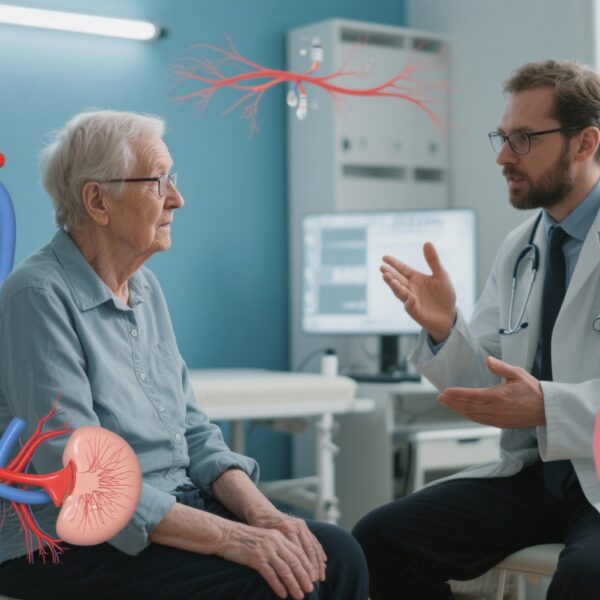Highlight
This analysis from the ADVOCATE trial subgroup evaluates avacopan versus prednisone taper in patients with ANCA-associated vasculitis (AAV) undergoing cyclophosphamide-based induction. Key findings include:
1. Comparable remission rates at 26 and 52 weeks between avacopan and prednisone taper.
2. Numerically lower relapse rates and significantly improved kidney function with avacopan.
3. Faster reduction in albuminuria and decreased glucocorticoid-related toxicity in the avacopan group.
4. Similar overall safety and serious adverse event rates in both groups.
Study Background
Antineutrophil cytoplasmic antibody (ANCA)-associated vasculitis (AAV) encompasses autoimmune diseases such as granulomatosis with polyangiitis (GPA) and microscopic polyangiitis (MPA). These diseases cause small to medium vessel inflammation, risking organ damage, particularly to kidneys and lungs. Traditionally, induction therapy includes high-dose glucocorticoids combined with cyclophosphamide (CYC) or rituximab, followed by maintenance agents like azathioprine or mycophenolate mofetil. While effective, glucocorticoids contribute substantially to morbidity through toxicity. Avacopan, an oral complement C5a receptor antagonist, offers a steroid-sparing strategy by interfering with a pivotal inflammatory pathway in AAV pathogenesis. The ADVOCATE study examined avacopan versus prednisone taper but here a subgroup receiving CYC induction is specifically assessed for efficacy, safety, and kidney outcomes.
Study Design
The ADVOCATE trial is a randomized, double-blind, controlled study enrolling patients with newly diagnosed or relapsing AAV (GPA or MPA). This subgroup analysis includes 116 patients receiving cyclophosphamide induction followed by azathioprine or mycophenolate mofetil maintenance. Participants were allocated to either avacopan or prednisone taper in addition to standard immunosuppression. Key efficacy endpoints were the proportions of patients achieving remission at 26 weeks and sustained remission at 52 weeks. Additional outcomes measured included glucocorticoid toxicity assessment, kidney function via estimated glomerular filtration rate (eGFR), urinary albumin-to-creatinine ratio (UACR) dynamics, relapse rates, and overall safety profile.
Key Findings
Among the 116 patients receiving CYC, remission rates at week 26 were 62.7% (37/59) for the avacopan group and 59.6% (34/57) for the prednisone taper group, indicating comparable efficacy. Sustained remission at 52 weeks was similarly close: 55.9% versus 52.6%, respectively. Relapses occurred in 13.0% of patients on avacopan versus 22.6% on prednisone taper, suggesting a favorable trend with avacopan. Kidney function trajectories favored avacopan, with a greater improvement in eGFR over the 52-week period and a faster decline in albuminuria, indicating better renal recovery and reduced glomerular injury. Importantly, the glucocorticoid toxicity score was lower in the avacopan group, reflecting reduced steroid side effects. Serious adverse event rates were nearly identical: 55.9% for avacopan and 56.1% for prednisone taper, supporting comparable safety. No new safety signals emerged with avacopan in this subgroup analysis.
Expert Commentary
The results from this subgroup provide clinically relevant insights for managing AAV patients requiring cyclophosphamide induction. Avacopan’s ability to deliver similar remission rates while minimizing glucocorticoid burden addresses a significant unmet need, given the high toxicity profile of prolonged steroid use. The observed renal benefits align with mechanistic understanding that complement inhibition attenuates C5a-mediated neutrophil activation and endothelial injury, pivotal in AAV pathogenesis. Although the relapse rate difference was not statistically powered, the trend toward fewer relapses with avacopan is encouraging for long-term disease control. The safety equivalence mitigates concerns about adding a novel agent alongside potent immunosuppression. Limitations include the modest sample size of this subgroup and the open question whether these findings extend to rituximab-based induction.
Conclusions
This subgroup analysis supports the use of avacopan combined with cyclophosphamide as an effective and safer alternative to prednisone taper in the treatment of GPA and MPA. Avacopan maintains remission rates while reducing glucocorticoid-associated toxicity and enhancing renal recovery. These findings underscore avacopan’s role in steroid-sparing strategies for AAV and provide a rationale for broader clinical adoption, especially in patients at risk for steroid-related complications.
Funding and Clinical Trial Registration
The ADVOCATE trial was registered under ClinicalTrials.gov identifier NCT02994927. Funding sources and disclosures are detailed in the original publication by Geetha et al. in RMD Open, 2025.
References
- Geetha D, Neumann T, Karras A, et al. Efficacy and safety of avacopan for treatment of patients with ANCA-associated vasculitis receiving cyclophosphamide. RMD Open. 2025;11(4):e005743. doi:10.1136/rmdopen-2025-005743.
- Jayne DRW, Bruchfeld AN, Harper L, et al. Randomized trial of C5a receptor inhibitor avacopan in ANCA-associated vasculitis. J Am Soc Nephrol. 2017;28(9):2756-2767.
- Yates M, Watts RA. ANCA-associated vasculitis: state of the art. Clin Med (Lond). 2017;17(1):60-64.



